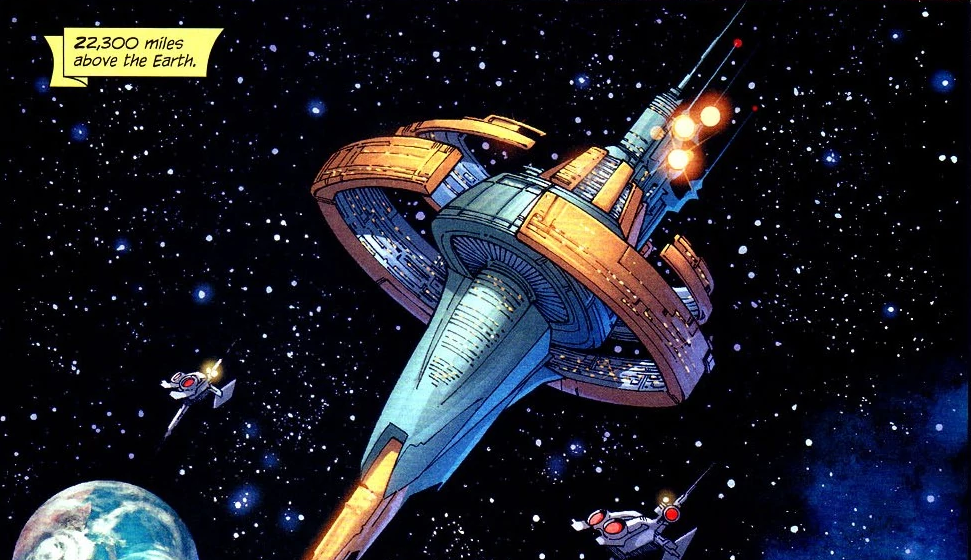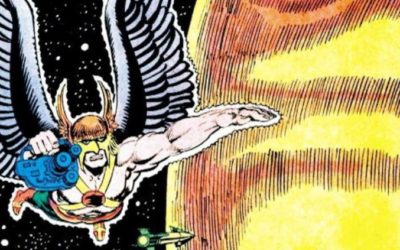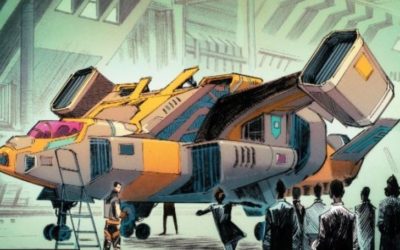The Justice League satellite is falling. And so is one in the real world.
One is a dramatic device being used to explore ethics in a fictional world, and the other is something that will probably be entering our atmosphere in a week or so.
Why do things in space come back down again, especially since they seemed to be working up there for years and years?
Let’s look at the science of two falling satellites, one fictional, one real. But first – some League background…
“The Fan”
Before we get into some science, let’s take a moment to look at the story behind the fall of the League’s satellite.
The larger story arc that the current issue (#40) is a part of is written by Christopher Priest (of Black Panther fame), and can be found at your local comic shop or online at Comixology. Priest’s run began with issue #34 and has focused on the League in a context that feels more “real-world” than the DCU has felt in a while. The crux comes down to this – “The Fan,” a former engineer/technician that worked on the construction of the Watchtower (the League’s satellite) is seeking to open the League’s eyes to their view of the world, and point at the ways the League could…rather, must be better. Instead of setting himself as a villain, he tells the League that he’s their biggest fan.
In the seven issues of the arc so far, important questions about the League’s behavior have been raised – who are they to decide who gets saved? Why do they help an upper-class neighborhood before a lower-class one during the same disaster? Can they be held liable when rescues go wrong, and people get hurt or even, die? It’s a messy story filled with characters who aren’t at their god-like heroic best. As I said – far more “real” feeling than the League has been in a while.
So far, it’s a dense read and like much of Priest’s other work, will benefit from re-readings as a collection.
Science-wise, Priest’s run has made a true effort to blend in real science with the comic book science, resulting in an enhanced realism. These are heroes who live and work in a world very much like ours, where laws physics and science apply, even if now and then, they can get bent by individuals who themselves may not follow them. It’s a refreshing change to see science embraced by characters who seem to know more than a little about it.
{Sigh} It’s Falling Again, Justice League?
The Justice League’s satellite headquarters was established as its headquarters in Justice League of America #78 in 1970. From the start, the headquarters was said to be geosynchronous, which meant that it had to be 22,300 miles above the earth and directly above the equator (as we explained here) but, depending upon the occasion, that that wasn’t always held as an absolute.
The satellite has been destroyed (fallen to earth) and rebuilt a few times since, and this time, it’s coming down thanks to The Fan(s) – which seem now to be an organization. In issue #40, while battling Aquaman and disabling the Watchtower, a “Fan” member tells Aquaman:
“We think having the world’s greatest defenders headquartered on a space station is a pretty dumb idea. Travelling 23,000 miles just for a stupid meeting is stupid and wastes time and resources…not to mention the risk involved in ‘beaming’ heroes the world relies on.”
That’s…
Okay, that’s hard to argue with.
Priest’s explanations of the satellite’s fall through the characters’ mouths is pretty spot on. Some science facts/setups about the Watchtower’s fall that are mentioned:
- The thrusters are disabled (along with the teleportation system, and the escape pods are gone).
- Communications are down, life support is down.
- The temperature is steadily rising.
- As the station falls, it’s gaining weight (not mass, as misidentified by Cyborg) and is harder to move.
- Superman is going to push the station along its trajectory to accelerate into the de-orbit curve.
- As it reenters, because the Watchtower is moving so fast, the air in front of the falling station will be compressed. Compressing air heats it up to around 3000°C, and that heat will be transferred to the Watchtower. It’s not friction or drag that does the heating.
- By himself, Superman cannot push the Watchtower back up to its orbit or slow its mass enough to guarantee the survival of everyone onboard.
- The Watchtower’s backup radiation shielding is water tanks mounted around the hull. The plan is to burst all the tanks, vent the water to the outside, and while that’s happening, Frost will supercool them, forming a giant chunk of ice that will absorb the heat and protect the people inside the station.
- The Ray has formed a light shield to act as a heat shield as the station enters the atmosphere. He’s pulsing it to allow some heat in, because Frost is able to turn heat into cold.
This is all pretty good stuff. Okay – except for that Frost stuff at the end.
That’s just magic.
By the way, the moral issue here is that, by trapping the Justice League and Batman’s Justice League of America offshoot group, only the strongest will survive to be the Justice League moving forward, hence the title of this issue’s story, “Selection.” And if you missed that, the tag for issue #40 at the end of #39 was “The League Versus Darwin.” It’s a fascinating setup – here are superheroes, beings of incredible power and ability, and most of them could very well die because they’re stuck in a can that’s falling back to earth. So much for said superpowers (and Aquaman’s reasoning that the Atom could shrink himself down to a microscopic size and get into the fibers of Superman’s suit to survive the trip back to earth, not to mention one of “The Fan” pointing out that thanks to living in water, Aquaman has an advantage when fighting in zero G…are a welcome return to characters who are…smart).
All that said, the League’s satellite is falling for reasons that are scientifically accurate: it’s slowing down.
Why Satellites Fall in Our World: Tiangong-1
Tiangong-1 (“Heavenly Palace-1”) is a Chinese space station about ten meters long and weighs about 9.5 tons. It has two modules, one for experiments and capsule docking for the human crew, and one for service, which is home to its solar panels and engines used for station keeping. The station was launched in 2011 as the first in a series of larger and more complicated stations. Tiangong-2 launched in 2016 and a third will be launched in the coming years. Tiangong-1 was never meant to be a station in which Chinese astronauts (Taikonauts) would stay for extended periods – it had only three visits, total during its run: one unmanned capsule, to practice docking, and two manned visits as practice for later stations and station operations.
The station’s original operational height was roughly 350 km. Currently, it’s at about 280 km above the ground and falling. Slowly, but still falling. As for the ‘why?’ – it’s the same reason the Justice League satellite is falling. Drag from the atmosphere.
Even though we’re used to thinking of space as a place where there’s no air whatsoever, that’s not true. Sure – step outside the ISS, and there’s not enough air for you to breathe, but there are still air molecules. The earth’s atmosphere – made up of the gases that are gravitationally held in by the earth – extends for hundreds of kilometers into space. Every satellite or other space vehicle in low earth orbit (up to about 2,000 km) has to deal with some atmospheric drag. And it slows you down.
Orbits around a body in space are directly related to the mass of the orbiting object, its velocity and indirectly related to its mass. The smaller your orbit, the faster you have to move. The larger your orbit, the slower you can move. If you’re at a specific orbit, and you start to lose velocity, gravity starts to win the battle and you lose altitude. This happens to all satellites, space stations and vehicles. All of them. Orbits decay because the thin atmospheric molecules hit the objects and steal some of their velocity.
To stay in orbit and not crash to the earth, a satellite has to perform periodic station keeping, or periodic engine firings to speed it up and push the satellite back up into its proper orbit. Satellites all have these engines or other mechanisms to handle this. The ISS has them too, but also depends on occasional pushes from resupply vehicles as well.
With the Watchtower, The Fan disabled the thrusters, and as a result the satellite’s orbit started to decay (okay, it’s falling a little quickly given its orbital height, but it was needed for the drama). What about Tiangong-1?
In 2016, the Chinese National Space Agency reported that it had lost contact with and control of Tiangong-1. The station keeping altitude boosts were no longer happening, and the station started to lose altitude. It’s been falling since.
Coming Home, Into Gravity’s Warm Embrace
Normally, satellites are directed back to earth at the end of their operational lives in a way that is similar to the above, but controlled. The craft’s engines are purposely fired to slow the object down at a specific time, resulting in re-entry following a planned path – most likely ending in an area of the South Pacific Ocean called the “Spacecraft Cemetery”
Not so much with Tiangong-1. With a loss of control, the station’s movements and subsequent re-entry are unknowns. As it loses altitude, the atmosphere gets thicker, slowing it more and increasing the rate of its orbital decay. At that point, a large number of variables come into play and predicting its re-entry location, date and time becomes exponentially difficult.
As Phil Plait explains, Tiangong-1’s original orbit had it moving between 43° north latitude and 43° south latitude, so it could come down anywhere in that band – which amounts to more than half of the planet – and most of that, water.
What about the heat? As Justice League #40 explained, Tiangong-1 will be moving with such high velocity that the air in front of it’s front-facing surfaces will be compressed rapidly. Compressing air heats it up. Compressing a lot of air up really, really quickly heats it up a lot. That heat from the air will be passed to the metal of the station, heating some parts up hot enough to glow and ultimately, due to heat and the forces associated with pushing through the air, Tiangong-1 will begin to fall apart.
Since the station is coming down before the end of its lifespan, it still has rocket fuel in its tanks (left over from the station-keeping that never happened), and those could explode – which would be a good thing. When debris comes down from space it has a lot of kinetic energy, which is dependent on mass and velocity. The velocity can’t be changed all that much, but if large pieces (those with large mass) break apart into smaller pieces (with less mass), the individual pieces will have less kinetic energy, and do, potentially, less damage – if they ever even reach the ground. Most of Tiangong-1 will burn to ash on the way down. Only the densest, heaviest pieces will make it to the earth, and, most likely, those will hit water.
Best case – about one day before Tiangong-1 makes its final orbit and re-entry, its trajectory will be mapped out – but even then, the best estimates will be +/- 20% which amounts to thousands of kilometers of the planet’s surface. And someone will capture the final fireball trail with a camera, and a few bits and pieces of the station will be found and shown on the news.
For more, check out the document the European Space Agency has assembled on its Rocket Science Blog: Tiangong-1 Frequently Asked Questions
Oh, and in the case of the Justice League Watchtower…look, they’re trying their best, and it’s a lousy situation, but that’s a lot of mass that’s coming down really, really fast. Even with Superman doing some manual station keeping and trying to keep the Watchtower “upright” as it falls, it’s going to be a rough ride for the folks onboard, a rough, re-entry, and a rough landing.
And just in case you were wondering – the tag for the next issue of Justice League is “Saigon.” Maybe an indicator of where the Watchtower will land?












